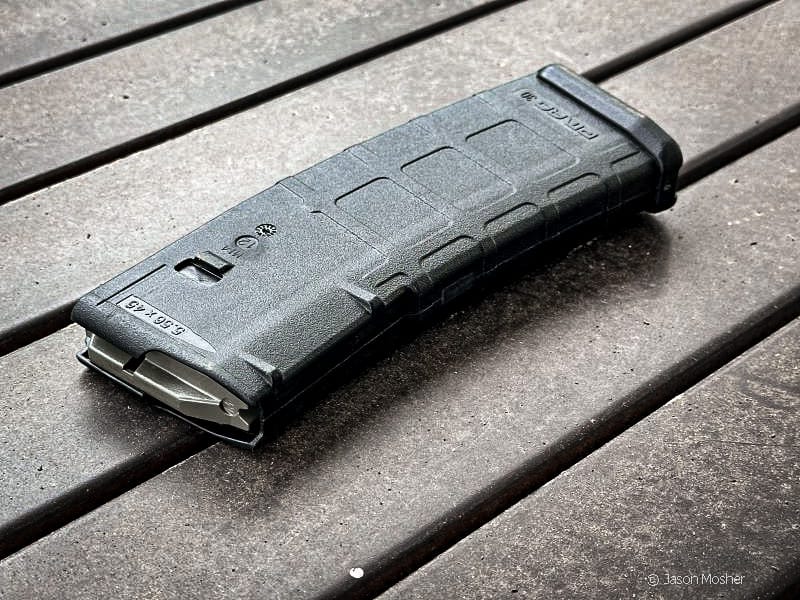AR-15 mags used to be a dime a dozen, and it didn’t matter where they came from. During the days of the Assault Weapon Ban, prices shot up so high that people were grabbing any mags they could get ahold of. While the price never returned to what it was pre-ban, it did go back down, and now we have options. Lots of options. Search “AR-15 mag,” and you will find the competition is healthy, and many companies are making AR-15 mags.
With so many options, there is much debate about which mags are the best. The military has stuck with metal mags for decades and still uses them. However, they have also approved the use of PMAGs, which have proven to be extremely durable. Translucent mags are becoming popular, with a multitude of tinted colors. Some companies even offer a monthly subscription for a newly designed magazine.

The Famous Magpul PMAG
Magpul has been making the PMAG for a long time and continues to improve upon its design. Their newest version is the Gen M3, but it does cost a little more money. The MOE (Magpul original equipment) Gen M2, however, is the cheapest and remains the most popular. PMAGs have become the gold standard in the polymer magazine world. They didn’t invent the polymer magazine, but they surely perfected it.
In their early days, Magpul manufactured attachments for AR mags that made them easier to pull from a mag pouch. Once they started producing the magazine itself, they set the standard in the magazine world. A large portion of AR-15 malfunctions are caused by the magazine. This is why the quality of an AR mag is so important. You may own the best AR in the world, but a faulty or cheaply-made magazine can cause it to fail.

If not designed correctly, the follower will bind in the magazine from the pressure of the spring and get stuck. That means no more ammo heading up into the chamber. The design of the PMAG, however, uses a constant curve to help prevent binding and to keep the ammo feeding properly.
Daniel Defense DD Magazine
Daniel Defense isn’t as well known as Magpul when it comes to magazines, but it is known for its high-quality rifles. Founded in 2002 by Marty Daniel, the company started out making sling loops for AR-15 rifles. From there, flat-top rails and forends landed the company government contracts and established a reputation in the gun world.
Over the years, Daniel Defense has won multiple other contracts with various government entities. Their quality, hammer-forged barrels, and ambidextrous design helped set them apart. Even though Daniel Defense’s magazines are not as popular as their rifles, they appear to be made of similar quality. I never paid any attention to their magazines until I purchased my first DDM4.

DD mags are carbon-fiber reinforced and have an aggressive surface grip texture. This is to provide a better grip on the magazine when loading and unloading. Daniel Defense states they have an anti-tilt follower in the magazine, but it clearly tilts a little when pushed in front of the follower. That doesn’t mean there is an issue with it, but some tilt is noticeable.

AR-15 Mags: Side-By-Side Comparison
When pushing on the followers, the spring is noticeably stronger in the PMAG. As I mentioned above, there is a noticeable difference in the movement of the follower. When pressing downward on the front of the follower, there is no movement in the PMAG. The follower on the DD mag tilts some as you push on it. If I were grading the anti-tilt design, this one would go to Magpul.
Both mags are easy to take apart by pushing in on the locking device on the bottom of the floorplate. The DD mag has a more robust track for the floorplate to slide onto. While the difference is noticeable, I can’t say I’ve ever had a PMAG floorplate come off when dropped. But I would give this one to Daniel Defense because it appears to be nearly impossible for this thing to come off when dropped.

Both mags stay locked in the rifle well, and both are easy to load. One of the most notable differences is the price. You can find PMAGS for about $8-$12, depending on the store and sale price. DD mags run $20-$23 and are harder to find than PMAGs.
Is there a winner?
When comparing these to mags, it’s easy to make an argument for either one, depending on what you want in a magazine. Daniel Defense mags are newer and not as proven as PMAGs, but the company has an excellent reputation for making reliable, quality products. While the follower does tilt some in the DD mag, I’ve put thousands of rounds through three of them without a single issue. However, I do like the no-tilt follower on the PMAG better.
The floorplate on the DD mag appears to be a little beefier than on the PMAG. The body construction on both is great, but I prefer the texturing on the DD mag. If I were going by look and feel alone, I would say my favorite of these two is the DD magazine. This may be caused by using the same PMAG design for years and wanting a new look.
However, when you consider the price, proven history, and availability, it’s hard to argue anything is better than a PMAG. Both are great AR magazines, and I feel both are reliable. They are well suited for multiple purposes, including home/self-defense. It will take some time before we have more history on the DD magazine, but I suspect, in time, they will earn the same reputation as their rifles.
This article was first published on The Mag Life on August 3, 2024